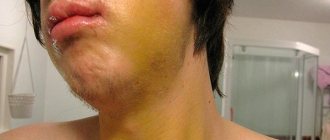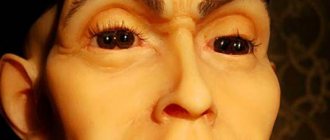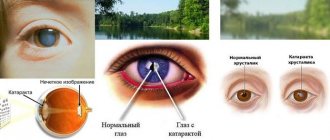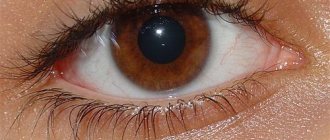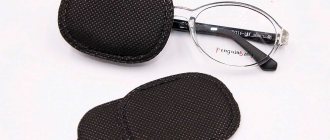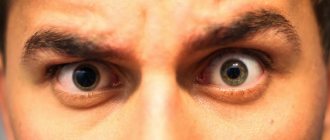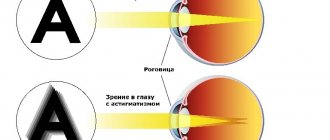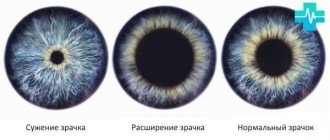Indications for use
Drops for pupil dilation have approximately similar indications for use, but the main ones are given below:
- Dilation of the pupil for a diagnostic examination of the lens and fundus (posterior segment of the eye).
- In ophthalmic surgery before phacoemulsification (lens replacement surgery), for ease of surgical access. Currently, atropine is rarely used for these purposes, since it creates persistent paresis of accommodation, which causes inconvenience to patients.
- Creation of mydriasis before laser coagulation of the retina (for diabetic retinopathy, PVRD, etc.).
- Preventing the formation, or rupture, of synechiae (adhesions) between the iris and the lens, which often occurs with iridocyclitis. If the adhesions are not broken in time, this can lead to the development of secondary glaucoma, secondary cataracts and other complications, which often lead to permanent loss of vision.
- Carrying out a diagnostic test for glaucoma. In patients with “borderline” IOP (21-25 mmHg) with unchanged visual fields, to confirm the diagnosis of glaucoma, it is possible to provoke a short-term increase in IOP by instilling mydriatics. Dilation of the pupil leads to blocking the angle of the anterior chamber of the eye, thereby increasing intraocular pressure (tropicamide is most often used for these purposes).
- Treatment of children over 7 years of age with accommodation spasm or PINA, but only after measuring true refraction using skiascopy or autorefractometry under cycloplegia.
Fundus examination procedure
Dilatation of the eye pupil can be achieved using special eye drops. When they get on the surface of the eye, they penetrate the tissue and do not allow signals to pass through to the muscle that constricts the pupil. Essentially, drops to dilate the pupils affect the receptors and they stop receiving the signal passing along the oculomotor nerve.
Previously, Atropine was instilled into the eyes; currently, tropicamide is mainly used - a safe medicine with rare side effects. Atropine is recommended for use if there is a suspicion of a spasm of accommodation (false myopia). Such procedures, which essentially improve vision, help to correctly determine whether the patient needs glasses and how strong.
The mechanism and duration of action of drops for dilating pupils
In order to dilate the pupil, there are currently 4 drugs, three of which are m-anticholinergics (atropine, cyclomed, tropicamide), and one drug is an alpha-adrenergic agonist (phenylephrine).
M-anticholinergics block the cholinergic receptors of the iris and ciliary muscle, causing paralysis of accommodation and relaxation of the circular muscle of the iris. An alpha adrenergic agonist (phenylephrine) relaxes the pupillary dilator (the muscle that is supposed to constrict the pupil), thereby causing it to dilate.
Let's consider the duration of action of the most popular drops for dilating pupils:
- Atropine
: duration of mydriasis/cycloplegia* - 7-10 days/10-14 days - Phenylephrine
: duration of mydriasis/cycloplegia* - 4-6 hours/does not occur - Cyclopentolate
: duration of mydriasis/cycloplegia* - 6 hours/up to 24 hours - Tropicamide
: duration of mydriasis/cycloplegia* - 30-40 minutes/up to 2 hours - Phenylephrine
: duration of mydriasis/cycloplegia* - 4-6 hours/up to 2 hours.
* Cycloplegia is paralysis of the ciliary muscle of the eye.
List of drops for dilating pupils
Here is a list of the most popular and effective eye drops for dilating pupils.
Atropine
Atropine 1% is the oldest drug from the mydriatic group. It began to be used about two hundred years ago, by dropping the juice of henbane, belladonna or dope into the eyes (or ingesting it internally). According to historical data, Helmholtz in the mid-19th century used substances containing atropine during eye examinations.
The mechanism of action of atropine is to block m-cholinergic receptors located in the smooth muscles of the iris, thereby relaxing it. This leads to dilation of the pupil and paresis of accommodation (it is impossible to properly examine objects either near or in the distance). Maximum mydriasis occurs after 30-40 minutes, and paralysis of accommodation occurs after 1 hour. This effect lasts for 7-10 days after a single instillation. Due to such a long-term persistence of mydriasis, atropine is currently used mainly in a 24-hour ophthalmology hospital in the treatment of children with visual impairment, or after eye injuries to prevent pupillary fusion.
Atropine 1% eye drops are sold only by prescription as they are a potent drug. Its price in pharmacies does not exceed 50 rubles.
Phenylephrine
A more modern substance for creating artificial mydriasis. Phenylephrine causes mydriasis due to its effect on alpha-adrenergic receptors (it is an analogue of adrenaline), while it does not affect the ciliary muscle. This means that cycloplegia does not occur, causing pupil dilation to persist for 4-6 hours without much visual impairment. This time is always enough to conduct an examination, perform an operation, and prevent the development of adhesions in the treatment of iridocyclitis.
Phenylephrine is sold in pharmacies under various trade names:
- Irifrin 2.5% and 10% (Sentisse, India). A 2.5% solution is prescribed primarily for the treatment of children with accommodation disorders, as well as for short-term pupil dilation for diagnosing the posterior segment of the eye. 10% Irifrin is intended for the treatment of uveitis (breaks the adhesions between the iris and the anterior capsule of the lens). Despite the high price (600-700 rubles) it is the most prescribed mydriatic drug in Russia.
- Irifrin BC 2.5% differs from the usual Irifrin only in that it does not contain the preservative benzalkonium chloride, which when instilled drops often causes discomfort and pain in the eyes, which children especially complain about. Accordingly, Irifrin BC is easier to tolerate. The price of Irifrin BC is the highest among all mydriatics: on average 650-700 rubles for 15 small dropper bottles.
- Neosinephrine-POS 5% and 10% (Ursafarm, Germany) is an inexpensive (about 290 rubles), but unpopular analogue of Irifrin produced in Germany. Available in most pharmacy chains.
- Phenylephrine-optic 2.5% (LEKKO, Russia) is the cheapest drug based on phenylephrine (220 rubles), but for unknown reasons, it is unpopular in Russia.
Cyclomed
Cyclopentolate belongs to the group of m-anticholinergic blockers, and acts on the iris and ciliary muscle in the same way as atropine, but more “gently”. After a single instillation of Cyclomed, pupil dilation occurs (due to relaxation of the circular muscle of the iris) and accommodation paresis (cycloplegia) occurs within 25-40 minutes, which usually persists for 8-12 hours.
The drug is used primarily for diagnostic purposes in clinics and or ophthalmological hospitals, as well as before surgical treatment of cataracts and vitrectomy.
Tropicamide
Tropicamide eye drops also belong to the group of m-anticholinergics, like atropine and cyclomed, but have two advantages over them:
- Pupil dilation and paralysis of accommodation occur within 10-15 minutes (for brown-eyed people after 20-25 minutes), which speeds up diagnostics in clinics;
- The wide pupil remains for 30-40 minutes - this allows you to get behind the wheel and engage in daily activities almost immediately after examination by a doctor.
Tropicamide is sold in pharmacy chains by prescription under the following trade names:
- Tropicamide 0.5% (Rompharm, Romania) is the leader in government procurement in the mydriatic category, as its price is only 48 rubles.
- Midriacil (Alkon, Belgium) is a very popular drug that is often prescribed by ophthalmologists for treatment, and is also used in daily work to dilate the pupil.
- Tropicam (Scan Biotech, India).
All of the drugs listed are prescription drugs, and it is impossible to buy them in pharmacy chains without a special doctor’s prescription (Form 148). This is due to the fact that drug addicts began to add it to intravenous drugs to enhance the narcotic effect and reduce the dose taken (mainly heroin) by almost 2 times. This has significantly complicated the treatment of patients with iridocyclitis, uveitis, and other inflammatory diseases of the anterior segment of the eye. In this regard, the drug Midrimax was developed.
Midrimax
About a year ago, the company Sentiss (India) released the drug Midrimax, which contains tropicamide and phenylephrine. This combination of substances turned out to be very successful:
- Pupil dilation occurs within 10-15 minutes and lasts for an average of 4 hours, which allows the drug to be used not only for diagnosis, but also for the successful treatment of iridocyclitis;
- Midrimax is approved for free sale in pharmacies. Since it contains phenylephrine, drug addicts, when administered intravenously with such a solution, experience all its “side effects”: increased blood pressure, difficulty breathing, headaches, difficulty urinating, etc. The only drawback of Midrimax is its rather high price - about 500 rubles. Only Irifrin and Irifrin BC are more expensive.
Most effective
Atropine, which is considered an indirect mydriatic, was used by girls who instilled this product into their eyes, since the enlarged pupil made them expressive and large.
Moisturizer - instructions for Ocutiarz eye drops.
M-anticholinergic
After instillation, vision decreases, discomfort and other unpleasant phenomena occur, which disappear only after a week.
Indications for the use of Mydriacyl drops, the main component of which is tropicamide, are:
- Fundus examination.
- Determination of the refractive angle.
- Treatment of adhesions and inflammation.
The drug is less likely to cause allergies than Atropine eye drops; it begins to act about twenty minutes after instillation, which allows the ophthalmologist to understand why vision is deteriorating. After 6 hours, the person already sees normally
Drops are not prescribed for small children; old people should use them carefully, because sometimes:
- Dizziness occurs.
- Feels dry in the mouth.
- The pulse speeds up or slows down.
- The conjunctiva turns red.
Instructions for natural antiseptic eye drops Okuflesh are presented here.
Alpha adrenergic agonist for topical use in ophthalmology
Tsmclomed is allowed to be used by women who are carrying and breastfeeding a child. The drug, the active component of which is cyclopentolate, is prescribed to determine refraction before cataract surgery, in the treatment of uveitis, keratitis, and iridocyclitis.
It is not recommended to use eye drops with these mydriatics for elderly people or small children. You cannot use Cyclomed if you have glaucoma or intestinal obstruction.
Mezatone is produced on the basis of Phenylephrine. It contracts the blood vessels of the eye, easily penetrates the tissue, and dilates the pupil within a quarter of an hour.
It is used to examine the anterior and posterior chambers, treat uveitis and iridocyclitis. Not prescribed for diabetes, problems with the thyroid gland, liver pathologies.
Irifrin increases pupil diameter by contracting the radial muscles. It is used in the diagnosis and treatment of eye diseases, but does not last long.
Appamide Plus is used for the same purpose, it has an effect already 5 minutes after instillation, two hours later, vision returns to normal. Despite their effectiveness, the drops have quite a few contraindications.
An angioprotector that reduces the permeability of the vascular wall - Emoxipin eye drops.
Active ingredient: phenylephrine hydrochloride
When there is no time to fight allergies - instructions for using Opatanol eye drops.
Contraindications and side effects
All mydriatics have similar contraindications for use and side effects, which are clearly shown below.
Atropine
Contraindications: closed-angle and open-angle glaucoma, even with stable IOP; keratoconus; children under 7 years of age.
Side effects: increased IOP (atropine is used only after tonometry); redness and swelling of the conjunctiva; systemic manifestations (during instillation they do not develop often, with large dosages): Headache, dizziness, constipation, tachycardia, hallucinations.
Phenylephrine
Contraindications: narrow anterior chamber angle (with moderate or high hypermetropia); age over 60 years (high risk of systemic side effects); hyperthyroidism; children under 12 years of age (10% solution); premature babies (2.5 and 10% solution).
Side effects: Increased IOP; blurred vision; lacrimation; conjunctivitis; systemic side effects: increased blood pressure, dizziness and headaches, tachycardia (in the elderly, hypertensive crisis, stroke and ventricular fibrillation may develop).
Tropicamide
Contraindications: Glaucoma (despite the fact that glaucoma is a contraindication, the drug is still used for diagnostic purposes in specialized ophthalmological centers, but only with stable low IOP)
Side effects: Burning sensation, feeling of a foreign body or sand in the eyes after instillation (no more than 5 minutes); blurred vision (associated with accommodation paresis); photophobia; increased IOP; allergic reactions (blepharoconjunctivitis).
general information
mydriasis fundus examination visual acuity accommodation myopia taractaractelaser coagulation retina
pharmachologic effect
The main active ingredient of the drug, cyclopentolate, is an m-anticholinergic blocker that blocks the corresponding receptors in eye tissue. This substance tones the muscle that dilates the pupil, and at the same time relaxes the muscle that constricts it. The drops are well absorbed through the outer layer of the eye (conjunctiva). Relaxation of the ciliary muscle of the eye, which is achieved when using Cyclomed, creates paralysis of accommodation - the eye temporarily loses the ability to adapt vision at various distances. It sounds scary, but there is no need to be afraid: this paralysis plays an important therapeutic and diagnostic role, helps restore eye function in certain diseases, and also helps the doctor distinguish true myopia from a spasm of accommodation, in which vision is impaired due to eye strain.
Contraindications
The use of Cyclomed is contraindicated in:
• glaucoma or suspicion of it;
• paresis of the sphincter of the pupil that occurs after injury;
• hypersensitivity to the components of the drug.
With caution, Cyclomed eye drops are used to treat children under three years of age and the elderly, as well as intestinal obstruction and prostatic hyperplasia. The use of these drops in pregnant or lactating women is possible when the expected therapeutic effect exceeds the possible side effects
Side effects
When using Cyclomed eye drops, side effects may develop: decreased visual acuity for some time, increased intraocular pressure, and immediately after instillation - redness of the outer shell of the eye, a feeling of discomfort. In rare cases, mainly in children or the elderly, weakness, nausea, dizziness develop, and heart rhythm changes.
Overdose
When taking Cyclomed eye drops orally or exceeding doses when instilling the drug into the eyes, symptoms of overdose may be observed - dry skin and mucous membranes, stimulation of the nervous system, increased heart rate, and disorientation in space. In these cases, a specific antidote of the drug, physostigmine, is administered intravenously.
Interaction with other drugs
With the simultaneous use of drugs with anticholinergic activity with atropine, the effect of the latter is enhanced.
Special instructions and precautions
Important! It is not recommended to drive a vehicle during treatment with eye drops that dilate the pupil, since the use of such a drug reduces visual acuity, the ability of the eye to adapt, and can also affect concentration and psychomotor reactions. If driving is your job, consult your doctor about alternative medications to treat eye problems.
What you need to know about Cyclomed eye drops?
What you need to know about Cyclomed eye drops?
1. Before using eye drops, an elderly person needs to measure intraocular pressure to rule out glaucoma.
2. Remove contact lenses before placing Cyclomed in your eyes. Lenses can be put on 15-20 minutes after instillation of the drug.
3. Store drops at a temperature not exceeding 25°C in a dark place, protected from children.
4. Do not use Cyclomed eye drops after the expiration date, which is 2 years.

